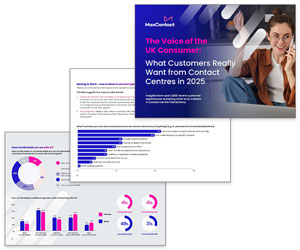Imagine if you could hear the emotions behind every customer call? No more guessing if an interaction is positive, negative or neutral.
Sentiment analysis allows call centres to understand the feelings behind the voices on the other end of the phone.
What Is Sentiment Analysis?
Sentiment analysis, also known as opinion mining, is a natural language processing technique. Textual data reveals attitude, sentiment, or emotion through analysis and assigns a positive, neutral, or negative label.
Sentiment analysis has many use cases within business, but is especially useful for understanding customer sentiments, interactions, and preferences.
Businesses can use sentiment analysis for a variety of reasons, for example, to monitor the perception of products and services or to improve customer experience by analysing reviews and feedback.
In a call centre environment, sentiment analysis provides valuable data that can be used to enhance:
- Customer experience
- Operations
- Agent performance
- Quality assurance
What Exactly Is Call Centre Sentiment Analysis?
Sentiment analysis is a feature of speech analytics software, an analytics tool used by many call centres. Speech analytics captures the raw words said in a conversation, while sentiment analysis considers the emotional meanings behind every customer interaction.
Call centre sentiment analysis technology evaluates emotions expressed by customers and agents through phone transcripts or online chats.
How Is Sentiment Analysis Used in Call Centres?
Sentiment analysis uses speech-to-text capabilities within speech analytics software. Real-time speech-to-text technology instantly transforms phone calls into searchable text.
Natural language processing then examines the text to detect emotional tone, gauging the level and direction of emotional expression, whether it be positive, negative or neutral.
Emotional tone considers several voice attributes, including:
- Word choice
- Phrases used within the context of a sentence
- Tone of voice
- Speech tempo
- Pauses
- Volume
- Voice quality (e.g. breathlessness, laughter, trembling)
Not all speech analytics solutions are capable of analysing phrases used within the context of a sentence. Some speech analytics tools only look at sentiment on a per-word basis, which means that it’s very easy to misdiagnose the overall sentiment of an interaction.
Let’s look at the phrase, “That’s flipping brilliant.” If we analyse sentiment on a per-word basis, it’s neutral, negative and positive. However, in its entirety, the phrase is undoubtedly positive.
If you’re considering speech analytics solutions, be sure to explore and compare their full capabilities.
Gain a Better Overview of the Customer Journey
Speech analytics combines sentiment insights with other metrics that automate quality assurance (QA). Auto QA provides insight on discussed topics, agent responsiveness to concerns, resolution rates and customer effort scores.
By linking these together, call centre managers have a better understanding of the whole customer service journey.
For example, they associate negative sentiment spikes with the dialogue exchange where an agent was being unhelpful or dismissive.
Analyse Trends and Patterns
Trends and correlations are generated through in-depth call analytics. For instance, do calls about a certain product cause more frustration than others? Does a longer call queue time match with initial negative sentiment when customers connect with agents?
These insights allow for targeted improvements. Such as adjusting hold music or having more staff for busy service or product lines.
Evaluate Agent Performance
Individual performance dashboards track sentiment, call dispositions, and other metrics. Dashboards show strengths and development areas to guide each agent’s development and training needs.
Those needing extra coaching are supported with one-on-one guidance when call recordings are flagged for negative sentiment.
It also highlights if particular types of calls are more challenging for the agent to handle. Using sentiment analysis can positively impact staff training, hiring and employee experience.
Why Is Sentiment Analysis Such a Valuable Tool for Customer Satisfaction?
When sentiment analysis is used well in call centres it positively benefits customers, agents and call centres as a whole.
Benefit 1: Real-Time Sentiment Analysis and Agent Assist Can Enhance Customer Experience
Here’s how:
- Agents can intervene early when negative emotions emerge before escalation
- Customers feel heard and understood when their emotional state is recognised during calls
- Issues can be addressed promptly as soon as negative sentiment is detected
- Customers get a more personable service and solution as it is based on understanding specific emotional needs
- Customers who have positive emotional experiences with the business or brand are likely to be more loyal
Benefit 2: Sentiment Analysis Can Improve Operational Efficiencies
Here’s how:
- Customer satisfaction and NPS scores improve
- Teams can identify highest value/happiest customers to focus their retention efforts
- Recognising positive sentiment highlights opportunities to upsell/cross-sell
- Teams can answer unhappy customer calls first to reduce churn
- Customer sentiment insights can be used to shape the service that’s given
Benefit 3: Sentiment Analysis Supports Better Agent Training
Here’s how:
- Management teams can tailor agent training and coaching to handle emotional callers effectively
- Sentiment analysis provides valuable insights to improve the quality and efficiency of onboarding, identifying areas for support and ensuring a more positive experience for new agents
- By analysing real call transcripts with various levels of customer sentiment (positive, negative, neutral), trainers can create training scenarios that simulate real-life situations and equip agents with strategies to navigate different emotional states effectively
By responding to customer emotion, call centres improve customer lifetime value – through better retention and service.
As for call agents, sentiment analysis makes the onboarding process much quicker and gives new and experienced agents confidence to problem-solve and navigate interactions positively. This translates into happy customers, happy agents and more revenue and growth.
What Role Does AI Play in Sentiment Analysis?
Artificial intelligence (AI) is becoming increasingly popular in call centre speech analytics, but not all speech analytics solutions are AI-powered.
There are many advantages to using AI speech analytics and sentiment analysis.
- Firstly, AI can handle large data volumes and analyse calls automatically – in ways that a manual approach can’t accommodate. This makes scaling up and resource management easier.
- The next positive influence that AI sentiment analysis has, is the ability to interpret complex emotions and small nuances in speech- removing bias and potentially exceeding human accuracy. By analysing these collectively, it’s possible to spot trends and patterns in the ways customers respond. From this, it’s easier to determine what makes a ‘good call’ and this can be standardised and followed by agents as best practice.
- AI tools learn and adapt, becoming more accurate over time as they analyse more data.
AI is already shaping call centre operations. It’s predicted that the role of AI in speech analytics will continue to dominate and will soon become the standard due to its ability to enhance engagement, contacts, service and experience.
Which Industries Benefit the Most From Call Sentiment?
Any call centre dealing with emotionally-charged customer conversations benefits from speech analytics and sentiment analysis. From onboarding, customer support and debt collection to renewals, claims and cancellations.
However, one vertical that can really benefit is sales. And for call centres that specialise in sales, sentiment analysis is an invaluable part of sales call analytics.
Remove the Guesswork
Automatically detecting customer emotions during sales calls helps the sales team understand pain points that complicate purchase decisions.
Knowing why prospects hesitate to buy lets agents address specific needs and trends, so they can tailor their pitches. By collecting continuous data, sales agents have a better understanding of the ‘why’ behind the buy.
Sell at the Right Time
Seeing which product features spark positive emotional reactions helps sales reps double down on discussing those strengths.
With insight into the emotions before purchase for each customer, agents can time targeted upsells and cross-sells to capitalise on spikes in purchase intent. And, instead of generic sales scripts, agents create customer-specific value propositions that trigger action.
Boost Conversions
Sentiment analysis removes the guesswork, making every sales interaction insight-led. This not only improves the ability of sales agents, but directly improves key call centre metrics like deal conversion, average order value and customer lifetime value. For sales-focused call centres, sentiment analytics optimises buyer journeys for revenue growth.
How to Implement Sentiment Analysis in Your Call Centre
While stand-alone sentiment analysis tools exist, integrating them within speech analytics software is the most beneficial. This removes the need for multiple systems and simplifies data management.
It also combines sentiment analysis with other call metrics and gives unified insights. Finally, it allows agents to access sentiment insights alongside call recordings.
This blog post has been re-published by kind permission of MaxContact – View the Original Article
For more information about MaxContact - visit the MaxContact Website
Call Centre Helper is not responsible for the content of these guest blog posts. The opinions expressed in this article are those of the author, and do not necessarily reflect those of Call Centre Helper.
Author: MaxContact
Published On: 25th Mar 2024 - Last modified: 6th Dec 2024
Read more about - Guest Blogs, MaxContact






 MaxContact is the AI-powered customer engagement software that helps you turn every customer conversation into a high-impact, revenue-driving moment. We empower your teams to connect smarter, perform better, and scale faster – without losing the human touch.
MaxContact is the AI-powered customer engagement software that helps you turn every customer conversation into a high-impact, revenue-driving moment. We empower your teams to connect smarter, perform better, and scale faster – without losing the human touch. 
































